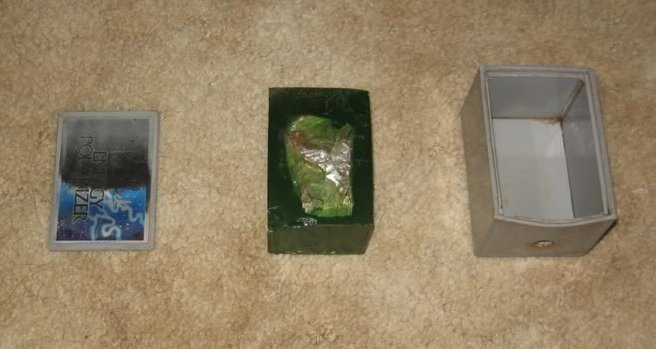I bought one from this travelling salesman...

Then opened up the unit to see inside...


Then opened up the unit to see inside...




goldierocks said:It can however, be useful in providing subsurface mapping of potential gem-bearing pockets, or "vugs."

Because precious opal occurs in well-defined stratigraphic and structural traps, geophysical surveys using magnetic, resistivity, shallow seismic and ground penetrating radar have been used with varying success. Recently it was discovered that the opal level and opals themselves are slightly radioactive and gamma ray logging of drill holes can provide evidence for the presence of precious opal, even if the drill hole was a near-miss and failed to bring opal fragments to the surface.
Between 1986 and 1990, the Department trialed electrical resistivity (Schlumberger
soundings), electromagnetic (TEM), (Leys, 1987 and 1990), seismic reflection, and
ground penetrating radar (Leys and Palmer, 1987) techniques in the Lightning
Ridge area.
The result of these trials showed that a small (25 metre), coincident loop transient
EM (TEM) survey resolved the electrical structure of the opal bearing environment,
(Leys, 1990 and figure 4). Seismic methods were not pursued further due to the
high cost of processing, while instrumental problems plagued the evaluation of the
GPR unit (Leys and Palmer, 1987).
As noted earlier, most economic gemstone
deposits presently are found at the surface or within
a few meters to tens of meters of the surface.
Examples include various alluvial deposits (where
diamonds, rubies, sapphires, spinels, and many
other gems are found), silica-rich sedimentary or
volcanic rocks (such as some opal deposits in
Australia and Mexico, respectively), pegmatite
dikes (where quartz, beryl [figure 11], tourmaline,
and a variety of rare gems are found), and lampro-
phyre (ultramafic) dikes (such as Yogo Gulch,
Montana, where sapphires are found). Each of these
deposit types may, if conditions are appropriate, be
amenable to exploration using georadar or, in some
cases, other geophysical tools.
mbasko said:GPR shouldn't be confused with these shonky handheld "devices". The handheld devices mostly contain nothing electronically that could even do anything remotely like claimed & are little more than dowsing rods with some LED lights + dials etc.
GPR has some learning to undertake in order to be able to interpret what it's telling you. Might be over a lot of us mug punters heads? Although I believe it's getting better & has been introduced into hybrid detectors with Minelab as a partner - don't get excited $30k minimum to purchase ATM..
There might be situations where it could be used. However keep in mind that it cannot detect the gems, it can only tell you if there is a subsurface cavity such as might be lined with crystals. So you would have to have such a situation in a gemfield, and understand the geology well, for it to have application in gem prospecting. There are such gemfields, but in most of Australia such situations are rare (I cannot think of such a situation for sapphires or zircon here, and we lack significant emerald or ruby fields, almost none in eastern Australia). These tend to be alluvial, or do not project into open cavities but are part of the rock in which they occur. It would work better with quartz gems and topaz, perhaps tourmaline and the occasional zircon occurrence, since we do take them from cavities and they are relatively common. But most of our gems are alluvial, unlike the ruby fields of Burma or the emerald fields of Columbia. But of course you cannot distinguish a cavity containing gems from any other cavity simply formed by weathering of the rocks, which will be scores more abundant.Dron said:From this document: http://citeseerx.ist.psu.edu/viewdoc/download?doi=10.1.1.595.8958&rep=rep1&type=pdf
Between 1986 and 1990, the Department trialed electrical resistivity (Schlumberger
soundings), electromagnetic (TEM), (Leys, 1987 and 1990), seismic reflection, and
ground penetrating radar (Leys and Palmer, 1987) techniques in the Lightning
Ridge area.
The result of these trials showed that a small (25 metre), coincident loop transient
EM (TEM) survey resolved the electrical structure of the opal bearing environment,
(Leys, 1990 and figure 4). Seismic methods were not pursued further due to the
high cost of processing, while instrumental problems plagued the evaluation of the
GPR unit (Leys and Palmer, 1987).
Tonnes of info on using GPR to look for Gems in here:
https://www.gia.edu/doc/Applications-of-Geophysics-in-Gemstone-Exploration
As noted earlier, most economic gemstone
deposits presently are found at the surface or within
a few meters to tens of meters of the surface.
Examples include various alluvial deposits (where
diamonds, rubies, sapphires, spinels, and many
other gems are found), silica-rich sedimentary or
volcanic rocks (such as some opal deposits in
Australia and Mexico, respectively), pegmatite
dikes (where quartz, beryl [figure 11], tourmaline,
and a variety of rare gems are found), and lampro-
phyre (ultramafic) dikes (such as Yogo Gulch,
Montana, where sapphires are found). Each of these
deposit types may, if conditions are appropriate, be
amenable to exploration using georadar or, in some
cases, other geophysical tools.
Enter your email address to join: